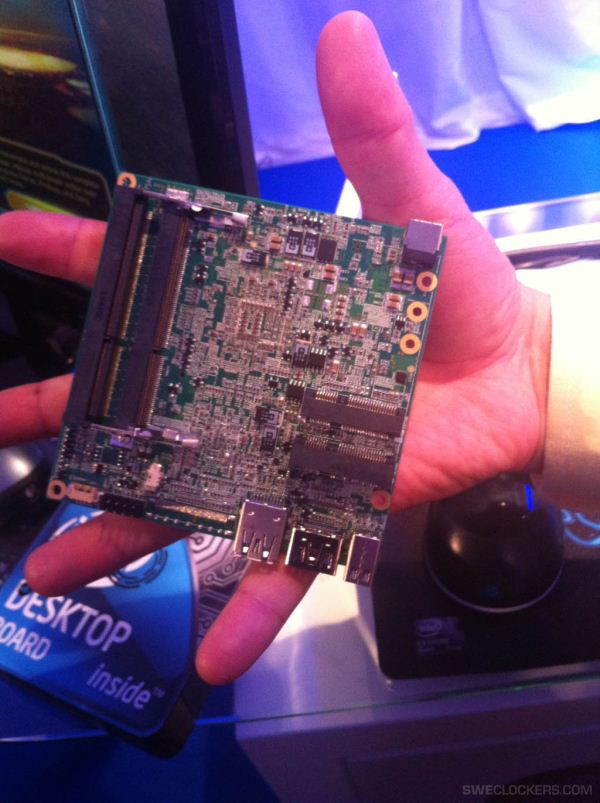Slimming Desktops Down: Intel Reveals Next Unit of Computing
by Kristian Vättö on May 2, 2012 12:25 PM EST- Posted in
- Trade Shows
- Intel
- Sandy Bridge
- Ivy Bridge
- NUC
Intel has demonstrated a new form factor at PAX East and Intel's Platinum Summit. The form factor carries the name Next Unit of Computing, or simply NUC, and measures in at 4" x 4" (or 10cm x 10cm for metric people). For comparison, mini-ITX is 17cm x 17cm so in terms of area NUC is 65% smaller.
Intel's demo unit was based on Sandy Bridge, although the exact SKU is unknown. Given the size, it's most likely a ULV i3 or i5. In terms of other specifications, there are two SO-DIMM slots and two mini PCIe headers for WiFi for instance. Connectivity is fairly limited with one each for Thunderbolt, HDMI, and USB 3.0 ports, though especially Thunderbolt can support multiple devices using just one port.
There is one thing that goes unmentioned: Storage. Intel provided absolutely no info on what kind of storage NUC supports. In fact, it's not even sure if there is a SATA port since the photos that SweClockers posted are fairly restricting. The dimensions of a 2.5" drive are about 100mm x 70mm x 9.5mm, so fitting one inside a NUC might be a tight fit. An mSATA SSD would be more logical due to the space limits, but SSDs would of course increase the price and/or limit the capacity. It's good to keep in mind that Intel's unit is most likely a protoype showing the idea behind NUC and it's not necessarily a final design—plus OEMs can always do their own designs—so it's hard to speculate at this point.
As this is not a final product announcement, pricing is also unknown. Our rough estimation for a low-end model would be $200-300 since Core i3 CPU alone is at least $100 (though mobile i3s are OEM only so specific price is unknown). Without knowing the exact configuration, it's hard to say how much other components would add to the price but we should be looking at close to $100 with a decent amount of storage and RAM. Then add manufacturing and profits and a $299 price tag sounds somewhat realistic.
The constraints of NUC definitely shape its market niche. While it could be inexpensive, a real desktop can be had for about the same money but with more expandability. Intel claims that NUC is mainly aimed at digital signage and kiosks, and I can definitely see NUC being useful in such environments. NUC could also be a good low-end HTPC if it's configured properly but I can't see much other use for it in a home environment, as a tower desktop is better in almost every aspect other than size.
It seems that NUC is Intel's attempt at bringing the ultrabook idea to the desktop side, and while we have only seen a couple of pictures it's definitely an interesting concept. We have seen what small desktops can do nowadays by looking at Apple's Mac Mini and mini-ITX builds. Even low-end mobile CPUs are more than powerful enough for everyday use, so a full-size tower may not always be a necessity.
Intel is saying that first NUCs should appear in H2'12. It's unclear whether the first models will be Sandy Bridge based, but given that Ivy Bridge is socket and chipset compatible with Sandy Bridge it would seem the more useful processor. Hopefully we'll get some hands on time with NUC in the near future.
Source: SweClockers











38 Comments
View All Comments
rruscio - Wednesday, May 2, 2012 - link
How about I fill my Lian Li hard drive slots with this thing, and someone builds me an OS that can use multiple CPU's without a nosebleed price.LB-ID - Wednesday, May 2, 2012 - link
NetFRAME managed to do that fifteen years ago, had a backplane that you just plugged slot-mounted mini-computers on a card into. Think they had a custom build of NT for it. I remember they were bought by MPC, and since MPC is defunct I dunno if anyone still has the intellectual property or not. Would be interesting to see it brought up to modern standards.SeleniumGlow - Wednesday, May 2, 2012 - link
This looks like Raspberry Phi on steroids.However, if some day in future, I get a powerful system even on a 10"x10" dimension, then it would be awesome.
Meaker10 - Wednesday, May 2, 2012 - link
Stacked PCBs, put a full ivy bridge, an MXM-B graphics slot, 2 USB3 on a couple of stacked PCBs with Heatpipes coming away to an assembly and it would be very compact.Lonyo - Wednesday, May 2, 2012 - link
Stacked mini boards?http://www.viaembedded.com/en/products/boards/prod...
Like this? (Again, VIA already did it).
Taft12 - Wednesday, May 2, 2012 - link
I think you just described blade servers...Lonyo - Wednesday, May 2, 2012 - link
In the words of South Park:VIA already did it.
Now Intel just need to catch up and go for the PicoITX form factor, 7.2cm x 10cm
http://www.viaembedded.com/en/products/boards/prod...
There's also NanoITX at 12cm x 12cm
http://www.viaembedded.com/en/products/boards/prod...
Nice that Intel have decided to give us higher performance in these form factors, although for digital signage I'm not sure how necessary such performance is. It's just a shame it's taken them something like 5 or more years to get there.
plonk420 - Wednesday, May 2, 2012 - link
obviously, via is known for their Intel-like CPU performance, as well >_>StevoLincolnite - Friday, May 4, 2012 - link
The Via Nano's single threaded performance is higher than Atom usually, which is what Via targets the chips at.JKflipflop98 - Monday, May 7, 2012 - link
. . . and an i5 (like in this computer) will destroy a Nano in performance.